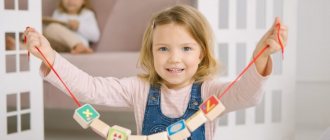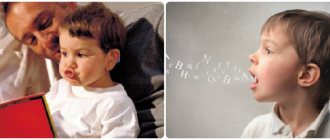The sound R is one of the most difficult sounds of the Russian alphabet to pronounce. Not even all adults manage to subjugate it, so what about kids. A special technique developed by children's speech therapists can help with this. She will tell you how to teach a child to say R, not by forcing the baby to study, but by playing with him.
At the first stage, it is important to correctly place the sound R, to make out the correct articulation during pronunciation.
At the second stage, this sound is consolidated in syllables, words, and sentences.
Exercises for pronouncing sounds
Initially, it is recommended to prepare cards that will depict animals and objects that have problematic letters at the beginning, middle or end. You need to observe whether the pronunciation of a complex letter always turns out to be problematic, or in some positions.
1. To master the letter “C”, it is recommended to use the following exercises:
- “Rails” (when the tongue must “ride” along the inside of the upper teeth).
- “Silence” (repeat the sound “t-sss” several times, stretching the letter “S”).
To reinforce the letter, you need to choose pictures or words where the letter “C” is present: sleigh, sieve, belt, sun, light. You can use sentences: Sasha sows seeds or poems:
"It's dark in the forest,
Everyone has been sleeping for a long time.
One owl doesn't sleep
She’s sitting on a branch.”
2. The letter “Z” is a brother of “S”, only voiced. Therefore, to teach a child to pronounce the letter “Z”, you need to pronounce “s” only by raising your voice. Show your baby by raising your hand to his throat how the muscles tense, making ringing sounds. We fix the letter with words: hare, animal, tooth, star, as well as sentences: A bunny in winter is like a small animal.
3. The letter “C” can be mastered by resorting to the “Silence” exercise, only you need to pronounce not “t-sss”, but “ts-ts-ts”. We fix it with words: heron, chicken, chain, pizza, and sentences: What color is the bird?
4. You can pronounce the letter “Ш” using a little trick: ask the child to pronounce the letter “s”, and use a spoon to lift the baby’s tongue to the sky. The sound will be “sh”. The letter is fixed with the words: awl, whisper, ears, noise; sentences: Our Masha rustles; and also in verse:
“Dear bear, Nice bear, Our bear is all made of plush.”
5. The same trick can be done with the letters “z” and “z”. You need to fix the letter “F” with the words: beetle, hedgehog, toad. And also in sentences: Zhanna is waiting for a book.
6. To master the letter “Ch,” ask your baby to say “t-t-t” while pressing the baby’s cheeks with your fingers. Then you will hear the cherished “h”. To reinforce the letter, ask your child to say the words: tea, turtle, daughter, ball; suggestions: Clean the siskin's bathtub.
7. The most common problem for parents is the problem of the letters “R” and “L”. Techniques and exercises for solving this problem are aimed at teaching the child to growl without swallowing complex letters and without replacing the complex “r” with the easier “l”:
“Horse” - together with your child, imitate the clicking and clattering of a horse’s hooves.
“Brush your teeth with your tongue” - ask your baby to smile widely. Then you need to run your tongue along the inner surface of the upper teeth. Make sure that the child's lower jaw remains motionless.
“Tease” - the child is invited to tease. To do this, the relaxed tongue sticks out and dangles up and down. The teasing is accompanied by a growl.
Special attention in teaching the letters “P” or “L” is paid to tongue twisters:
- The Greek was driving across the river, he saw the Greek: there was cancer in the river.
- There is grass in the yard, there is firewood on the grass: one, two, three there is firewood.
- The brave man ate thirty-three pies, all of them with cottage cheese.
- You can’t say all the tongue twisters quickly.
Games with a child aimed at producing the sound R
To quickly master the pronunciation of R, the baby should pronounce this sound as often as possible. Constant training of the articulatory apparatus will certainly bear fruit and help the child quickly master difficult sounds. For this:
- Talk to your baby more, adding as many words containing the letter R to your vocabulary as possible. Pronounce these words yourself, trying to pronounce them clearly and correctly, and force your child to pronounce them correctly as well.
- Play onomatopoeia with your child. Roar together like a lion - rrr-rrrr, purr like a cat - purr-murr, shoot from a machine gun - tra-ta-ta, start the car engine - drrr-drrr. Repeat any sounds around you that contain the sound R, making it a fun and exciting activity.
- Compose fairy tales and stories with your child, making the main character a mole, pig, rabbit, turtle or other characters, giving them names that contain the letter R.
- Learn nursery rhymes or tongue twisters where the letter P appears frequently. Here are some similar examples:
Roma was afraid of thunder. He roared louder than thunder. From such a roar the thunder hid behind a hillock.
I'm a piggy, I'm a piggy, I'm bathing my belly in a puddle. Why take a shower, since there are so many puddles in the world.
The Greek was driving across the river, The Greek sees a cancer in the river, He put the Greek’s hand in the river, The Cancer grabbed the Greek’s hand.
How to teach a child to pronounce the letter Z
Let's consider the main ways of forming the sound Ж in children, depending on the disorder:
- Setting sound when skipped. Sound may be lost in speech. Parents do not hear sound where it should be. In this case, you can teach a child to pronounce F by imitation. Ask him to sing the “Bug song” and pronounce the sound Zh after you for a long time. If the child has intact phonemic hearing, it will not be difficult to pronounce the letter Zh.
- Sound production during replacement and mixing (parasigmatism). In this case, the sound is replaced with simpler ones in articulation: , . This defect is easily perceived by ear. Sound production should begin with articulatory gymnastics.
Invite your baby to do tongue exercises for 5-10 minutes every day. The complex for hissing sounds consists of three main exercises and will allow you to form the correct articulatory pattern:
- “Cup”. Ask your child to place the tongue behind his upper teeth and hold for five seconds. A break is taken between exercises so that the tone of the tongue muscles is restored.
- “Tube.” Show your child how to stretch out his lips with a straw. Elongated lips should be held for five seconds.
- “Painter.” A complex exercise that is carried out after successfully mastering the “cup”. The tip of the tongue strokes the hard palate, like a painter paints the ceiling with a roller.
All exercises are carried out in front of a mirror, the child must see himself
During gymnastics, you need to praise your child for the slightest result and try not to pay attention to failures. Parents should not hope for a quick positive result, because producing sounds is a long, painstaking work
It is important to remember that when pronouncing a sound, a strong air stream is necessary. Here, parents will be helped by a variety of toys: harmonicas, paper pinwheels and everything else that you can blow on
The child should be helped to learn to exhale forcefully through the mouth. As you exhale, ask the child to make the sound. Sound distortion (sigmatism) is a complex disorder. In this case, there is a distorted pronunciation of the sound: interdental, lateral, nasal. The correct sound pattern is not formed. The tongue occupies a position either between the teeth, behind the lower teeth, or near the soft palate.
To correct the defect, you must contact a specialist and attend special classes. In this case, it is recommended to carry out the complex of articulatory gymnastics presented earlier, as well as to develop the child’s phonemic hearing.
There are a number of games to develop phonemic awareness. It is necessary to start classes with simple games to distinguish non-speech sounds. Here various sounding toys will come to the rescue: boubouin, drum, bell, squeaker. Invite your baby to listen to how each toy sounds, and then choose one and, hiding it behind his back, make a sound to it.
The child must guess which toy was playing now. Jars of cereal can serve as toys, since small and large grains rustle differently in the jar. Next, you can move on to forming the perception of speech sounds. The child should be taught to distinguish sounds from similar-sounding phonemes.
The game “Catch the Sound” will help parents with this. Invite the child to clap his hands when he hears the sound among other sounds: Ш, Ж, Х, Х, ШЧ, Ж, Ф. Next, the game can be complicated and asked to find a syllable with the letter Ж: SHI, ZHA, HO, SHU, ZHE, SHA, CHI, ZHU. And also an option with words and sentences.
- After successful training, you should consolidate the result and move on to the automation stage. It is necessary to control the child’s speech and encourage correct pronunciation not only in speech therapist classes, but also at home. In the first stages, exaggerated pronunciation of the sound is possible, but this is not a problem. The articulatory apparatus gets used to the new way of life, which takes time.
Tips for parents when setting up sound:
It is necessary to monitor the baby’s speech development
Early detection of violations facilitates quick and correct correction. For complex forms of the disorder, you should seek the help of a speech therapist. It is necessary to follow the recommendations of the speech therapist, this will contribute to the success of the correction. It is important to talk with the child and stimulate the baby’s speech activity. Praise your child for the slightest progress in development.
It is important to know that love, attention and care for a child are the key to success in the development of the baby!
How to use the speech therapy alphabet?
All ABC exercises are aimed at developing and shaping the skills of a child aged 3-6 years to correctly pronounce individual sounds, as well as clearly pronounce whole words.
- While looking at the pictures, ask your child to indicate those in which a particular sound occurs, and also to determine the place where it stands: at the beginning, in the middle or at the very end.
- The Echo game, where your child needs to repeat after you, is perfect for poems and rhyming lines. During the process, you can change the intonation, volume of your voice, and the speed of pronunciation of words.
- If exercises for speech development are too easy for your child, you can always make them more difficult. You can ask questions based on the pictures or ask the little storyteller to come up with a short story based on the illustration.
Note!
Correct pronunciation is formed in children over a fairly long period of time, up to 5 years. Moreover, this happens individually for each child. Some people begin to pronounce almost all sounds by the age of 3, while others begin to pronounce them by the age of 5-6 years. If, even after reaching this age, there are difficulties in pronouncing any sounds, it is recommended to seek help from a speech therapist.
Depending on age, attention should be paid to the pronunciation of the following sounds:
- for children 4-5 years old sounds: b(b), t(t), m(m), d(d), n(n), g(g)‚ x(x), k(k), y, f(f), v(v) and sounds c, s(s), z(z);
- children 5-6 years old should already be able to clearly and correctly pronounce all sounds, and also distinguish by ear such groups as: s-ts, zh-sh, s-z, ch-sch, z-zh, ts-ch, s- w, s(s), sch, l-r.
- By the age of 7, you need to work on consolidating the correct pronunciation of hissing and whistling sounds, as well as the ability to differentiate: s-sh, z-zh, ts-ch, s(s)-sch, deaf and voiced: p-b, k-g , t-d, f-v, sh-f, s-z, hard and soft: t-t, v-v, p-p, l-l, r-ry, s-s.
Developing speech
Parents in their child’s speech are mainly frightened by the incorrect pronunciation of the sound “r”, which is the most difficult. However, you shouldn’t start panicking before the child turns 5-6 years old, because children can learn to pronounce this sound precisely by that age.
Here are some reasons why children cannot pronounce the sound “r” correctly:
- Short hyoid frenulum.
- The sound is not automated.
- The child imitates those who pronounce the sound incorrectly.
- Phonetic hearing is underdeveloped.
- The baby replaces this sound with another.
- A speech disorder that is associated with damage to the cerebral cortex. In this case, an integrated approach from more than one specialist is needed.
How to learn to pronounce the letter R
An important condition for sound production is systematicity. You need to work with your child for 15-20 minutes every day. And this is not only classes with a speech therapist.
At home, parents should use exercises that will help develop the necessary tongue movements. Gymnastics should be done every day, but make sure that the child does not get tired. Go from easier to more complex exercises, perform them slowly at first, and gradually increase the number of repetitions.
It is better to do all exercises in front of a mirror until the baby learns to do them confidently. We also recommend doing them together with your child so that he imitates you.
Turkey
Open your mouth slightly and try to quickly move the wide tip of your tongue back and forth along your upper lip, while pronouncing a sound that is close to “bl-bl-bl”. This sound must be sustained for 5-7 seconds, after taking a deep breath.
Fungus
Open your mouth and show your teeth. Clicking your tongue, suck your flat tongue to the roof of your mouth and hold in this position for 5-10 seconds. The “mushroom stem” is the frenulum of the tongue, and the “cap” is the tongue itself. Repeat the exercise 2-3 times.
horse
Open your mouth slightly and smile, showing your teeth. Start clicking your tongue slowly, then faster, faster and again slowly. This should be done with short pauses. At the same time, try not to move your lower jaw.
Painter
Open your mouth wide and smile, showing your teeth. Move the tip of your tongue back and forth across the palate (to the teeth and further towards the neck), as if “painting the ceiling.” The tongue should not pop out behind the teeth, nor move left and right or open from the “ceiling”. Also, the lower jaw should not move. Repeat this exercise 5-6 times in each direction.
Delicious jam
Using the flat, wide tip of your tongue, lick your upper lip from top to bottom. In this case, it is necessary that the lower teeth are visible (pull the lower lip down, the teeth should not bite the tongue). Repeat 3-5 times.
Tongue twisters for combining the sounds L and R
Lara and Valya are playing the piano. Hail fell on five ridges. The king is an eagle, the eagle is a king. The liar put it in the chest. Malina is not Marina. Marina was sorting raspberries, and Arina was pickling mushrooms.
Tongue twisters for making the sounds Рь and Р
Good beavers are coming and going. Radishes and turnips have strong roots. Three crows on the gate. The beaver is kind to the beavers. The baker Peter was baking a pie. Three crows are on the gate. Three magpies are on the doorstep.
Speech therapy exercises for producing the sound R
Despite the fact that training in the pronunciation of the sound R is important and necessary for correct speech, it is not enough on its own. No less important is articulatory gymnastics, aimed at developing those muscles of the language apparatus directly involved in the pronunciation of the sound R.
Speech therapists have developed a whole range of exercises that children can easily do at home with their parents. In this gymnastics, the frequency of practice is very important - daily and preferably two to three times a day. And also joint work: using the example of parents, the child should see how to perform the exercises correctly.
Each specialist develops his own method for producing the correct sound R. But there are a number of exercises that all speech therapists use.
"Cup"
Give the tongue a cup shape - the edges are raised and the middle part is lowered. You need to hold your tongue in this position for 10-15 seconds, then relax it and repeat the exercise again. This must be done at least five times.
"Spatula"
Stick out your tongue a little and give it the shape of a shoulder blade - make it straight and wide. Also hold this position for 15 seconds and repeat several times.
"Brushing our teeth"
We part our lips in a wide smile so as to reveal the upper teeth. We clean the teeth from the inside with our tongue, acting like a whisk. A very important point is that only the tongue should work, and the jaws should remain motionless.
"Clapping"
Play horse with your child - click. This simple exercise will help strengthen your tongue muscles.
"Inside out"
Stick out your tongue and in this position try to pronounce different words with your child. It will turn out funny, and at the same time you will do a good warm-up for your tongue.
"Lapping Milk"
Invite your baby to repeat the cat's actions and drink tea, compote or juice. This simple exercise strengthens the muscles of the tongue.
"Long tongue"
Compete with your child and invite him to touch his nose or chin with his tongue.
Relaxing the muscles of the tongue
You need to open your mouth wide, stick out your tongue and place its tip on the tubercles of your upper teeth. Hold this tongue position for 20 seconds and repeat at least three times. This is a very effective exercise that will teach the child to relax the muscles of the tongue and stretch the hyoid ligament.
"We bite our tongue"
We smile and bite the tip of our tongue. This exercise will help excite the tongue muscles.
"Woodpecker"
We open our mouth wide in a smile and hit the tubercles of the upper teeth with the tip of our tongue. In this case, you need to pronounce the sound D. First, pronounce the sound D slowly, then gradually increase the tempo. During the exercise, you must ensure that the jaw is motionless and the mouth remains in a smile. We do the exercise for at least 15 seconds.
If you follow all the suggested recommendations diligently, taking advantage of every opportunity, then your child will very quickly conquer the sound R. And thanks to the playful form of the exercises, the process of practicing with the articulatory apparatus will become exciting for both children and parents.
Video with articulatory gymnastics for clear pronunciation of the sounds r, r:
How to teach a child to speak L. Basic recommendations
You can teach your child to pronounce “l” using the following recommendations:
- To begin with, parents should tell their baby about the main speech organs that take part in the formation of sounds. We recommend doing several articulation exercises with your baby, presenting them in the form of a fascinating fairy tale. This game will allow you to quietly and funly train the muscles of the tongue, cheeks and lips;
- The child must constantly work on establishing speech breathing, and parents need to help him with this. Please note that human speech is formed during exhalation. Incorrect sound pronunciation occurs due to uneven distribution of air during exhalation. That is why, in order to correctly pronounce the letter “l”, the child will learn the correct breathing pattern. A child can also develop proper breathing through play. For example, blowing out imaginary candles or blowing soap bubbles. During such games, parents should ensure that the baby takes in air not “by the cheeks”, but into the lungs;
- Stimulation of speech development is also facilitated by games and activities aimed at developing fine motor skills of the hands and fingers. With your baby, you need to draw patterns more often, sculpt from plasticine or fold mosaics;
- The correct pronunciation of the letter “l” is carried out with open teeth and a slightly open mouth. The tip of the tongue should rest against the base of the upper teeth, and the air during the pronunciation of the letter “l” should come out along the edges of the tongue.
Speech therapy exercises for correct pronunciation of the letter “L”.
To find out how to teach a child to pronounce “l”, parents need to consult a speech therapist. We recommend performing a set of such exercises (parents should do them together with their child):
- “Breeze” - the child should smile, opening his mouth slightly. Then you need to lightly press the tip of your tongue with your teeth and try to blow;
- “Horse” - to perform this exercise, the child needs to smile again, showing his teeth. Next, he should be asked to click like a horse, but at the same time try not to move his lower jaw and gradually increase the speed of sound pronunciation;
- “Steamboat rumble” - the child must utter a long “y” sound with his mouth slightly open. When pronouncing, the tip of the tongue should be lowered down, and the root, on the contrary, should be raised up;
- “Jam” - invite the child to lick his upper lip with the wide tip of his tongue, moving from top to bottom. When performing this exercise, you cannot move your lower jaw.
The older the child, the more difficult it will be to correct incorrect pronunciation of letters. If parents notice incorrect pronunciation of the letter “l,” they should immediately visit a speech therapist with their child and begin performing corrective exercises.
Types and mechanisms of sound impairment L
With the correct articulation of the sound, the lips open slightly, take the articulatory position of the vowel following it, there is a small gap between the incisors, the tongue relaxes, its tip is raised to the alveolar process and touches the gums, the lateral edges create gaps with the molars, an air flow passes through them with exhalation, the root the tongue is slightly raised, the vocal folds are connected and tremble. The sound is consonant, hard, voiced, oral, sonorant, occlusive, anterior lingual.
Impaired pronunciation of sound is called lambdacism. There are several types:
- Interdental. The correct sound is heard, but the articulatory position is disturbed: the tip of the tongue is located outside, clamped between the teeth.
- Nasal. Pronunciation deviates greatly from correct articulation and acoustics. The tongue touches the palate, part of the air or all of the exhaled stream goes into the nose. A blurry combination is heard.
- Labiolabial (bilabial). It sounds similar to, or English. With such lambdacisism, the phoneme is reproduced by the lips, the tip of the tongue is located deep in the mouth, and is not involved in articulation.
- Labial-dental. Sounds similar to . The lower lip meets the upper teeth, the tongue is located deep in the mouth.
- Side. The air flow exits through one side slot, the second side of the tongue is connected to the upper molars.
- Mitigation. An intermediate sound between hard and soft. The middle of the lingual dorsum rises more than required.
Replacing the sound L with other sounds is called paralambdacism:
- Change to . The back of the tongue arches and the tip drops. A person does not even recognize the replacement; he often thinks that the phoneme is simply missing.
- Change to . The tip of the tongue does not rise, but is relaxed and located deep in the mouth, the back of the lingual back, curving, is adjacent to the soft palate.
- Change to . With such a distortion, the tip of the tongue is located at the bottom of the mouth, and does not rise to the alveolar process, and the middle of the back is bent upward.
- Change to . Articulation involves the lips instead of the tongue.
- Change to . With this variant of paralambdacism, the lower lip is adjacent to the upper teeth. A person usually considers this speech disorder to be simple slurred speech.
In addition to the listed options for incorrect pronunciation of the phoneme, its complete absence is possible.
Speech development techniques
Conversation between mother and child. The mother spends a lot of time with the baby. Tactile and verbal conversation is important to him. It is necessary to hum to the baby so that he can see mommy’s face and articulation. Comment on your actions. Tell your baby everything you do. Talk to your child so that he can see your face and your articulation. At the age of 1.5 - 2 years, the mother should conduct a conversation with the baby in the usual rhythm and tone. Only when it comes to new words, special attention is paid to articulation and stress. Don't replace complex words with simple ones
Call a spade a spade. Don't forget about verbs. Use contrast. For example: a bird flies - a dog runs. Read poems, nursery rhymes, fairy tales from the very beginning. Play with words, syllables, sounds. It is important to improve the development of fine motor skills. Let your baby play with cereals, pasta, and dough. Children with well-developed fine motor skills are able to think logically, they are attentive, and they begin to talk and write faster.
How to teach a baby to speak
The first signs of speech appear in the baby at the age of 4 months. It is during this period that a small child begins to make sounds that are commonly called humming. Initially they are short-lived. Gradually, the child gains confidence and begins to make longer sounds. Of course, speech at this age is meaningless. This is more a sign that the baby is in a great mood. Recommendations and useful tips for speech development and to teach the baby to speak during this period are as follows:
Communicate with your child more often. Get his answer with any sound or laughter. Capture your baby's attention with toys, while clearly pronouncing their names.
At eight months, the child begins to form individual syllables. This can be compared to babbling. At this age, children are already able to imitate certain sounds. The baby is also able to make the intonation of his speech more expressive.
At this age, children pronounce words in different ways, while stress and intonation are arbitrarily modified. To teach a child to speak, it is during this period that it is necessary to communicate with the child more often, show him toys and objects, clearly pronounce their names, and also talk about animals and explain various actions. Everything needs to be done clearly and clearly so that the child understands exactly what you are talking about. It is worth encouraging the baby to perform certain actions, for example, open his mouth, give a toy. You should not replace the names of objects with more simplified ones, as this only slows down the development of speech. These little tips will help you teach your child to say words and sounds correctly over time.
Cooperative games
Of course, during this period you should not use words that are difficult to understand. At one and a half years old, the baby is already able to express himself in words. His vocabulary at this age should consist of at least forty words. In this case, the main burden falls on the interlocutor, since he must carefully describe the world around him, animals and objects, using verbs, adjectives and other parts of speech in his speech. You should also indicate the relationship between individual parts of speech, for example: “Look, the cat is playing with a sunbeam.” At this age, there comes a time when it is necessary to turn to the baby with more complex requests, for example, ask him to bring a pen or open a book for the baby. During this period, emphasis should be placed on increasing the child’s vocabulary. By the age of two, a child’s vocabulary should be at least 300 words. At three years old, the child should already be able to use subordinate clauses. At this age, it is necessary to encourage your child to change the endings of individual words, as well as to coordinate them in a sentence. In order for a child to feel confident, it is necessary to encourage his desire to speak. Let's move on to the following tips on how to teach a child to speak correctly and pronounce the word mom, dad and various sounds such as sh, l, r, zh.
What prevents a child from pronouncing r?
Hyoid frenulum (small membrane located under the tongue). By the age of six, the child’s tongue frenulum should stretch to 8 mm or more. If it is short, thick, and inactive, difficulties may arise with the sound “r”. In this case, you need to either try to stretch it with the help of special exercises, or trim it at the clinic.
Impaired sound pronunciation. A problem with earlier sounds (for example, a child confuses whistling and hissing sounds) may later result in a problem with the sound “r”. Most likely, the pronunciation of this sound will also be impaired.
If a child pronounces the sound “l” instead of the sound “r”, the situation is normal and can be easily corrected. These two sounds are similar in terms of the position of the tongue, but pronouncing “l” is easier, and the child, hearing “r” in someone else’s speech and trying to repeat it, chooses the simplest method. If a child replaces the sound “r” with other sounds, the situation is more complicated, but in this case we can say that he hears it.
If a child misses a sound or swallows, it can be assumed that phonemic perception of sound is impaired.
Phonemic hearing impairment. The hearing aid cannot perceive all speech, but only individual sounds. In this case, we are talking about a violation of phonemic hearing, which manifests itself in the form of problems with distinguishing sounds.
The peak development of phonemic hearing occurs at the age of 4-5 years. But even before this age, you can notice that the child hears differently. When pronouncing words, he makes substitutions of sounds or skips individual sounds.
Signs of phonemic hearing impairment are a serious reason to take your child to a speech therapist. The cause of impaired phonemic hearing may be damage to the central nervous system, or it may be ordinary adenoids or previous otitis media.
Tone of the articulatory apparatus (tongue, cheeks, lips). Skipping sounds may also indicate insufficient development of speech muscles. A child’s speech muscles may be either insufficiently mobile (hypotonicity) or too tense (hypertonicity). In both cases, sound pronunciation suffers.
Behavioral problems. As we have already said, mastering the sound “r” requires the greatest effort from the child. Making the “r” sound is especially difficult for children with behavioral disorders such as attention deficit hyperactivity disorder (ADHD). No less problems with learning pronunciation arise in tonically relaxed children.
Throat "r". If a child has developed according to norms, hears all sounds and the process of mastering speech has not caused him any problems, he does not have the habit of working on acquiring speech skills. In this case, when trying to reproduce the sound “r”, he can take the path of least resistance and replace the difficult to pronounce “r” with a simpler option, namely the laryngeal “r” (in this case, the vibration occurs due to the laryngeal uvula).
Correcting the “r” in the throat is very difficult, since in this case relearning is required. In this case, you definitely need to contact a speech therapist. The situation is further complicated by the fact that many parents simply cannot distinguish the “r” in the throat from the “r” in the tongue.
In all these cases, the most important thing is to correctly determine for what reason the child cannot independently cope with the sound “r”. And the best solution is to contact a speech therapist
A qualified speech therapist will check the frenulum and tone, phonemic hearing, determine the throat “r” (if it is present) and, if necessary, draw up a correction route. If correctional assistance is not needed, you can try to develop the “r” sound yourself.
Gymnastics for children's language
One of the main roles in the formation of the correct pronunciation of sounds and in the development of a child’s speech is played by the “tuning” of his articulatory apparatus. To do this, you can use the following exercises:
- “ Who lives in the house? " First the tongue sticks out, and then hides back. At the beginning, the exercise is done slowly, and then the pace accelerates;
- " Watch ". The tongue sticks out and moves from left to right, like a clock pendulum;
- " Swing ". The tongue protrudes, its tip bends and so it either rises or falls;
- " Horse ". You need to click the tongue, pressing it to the sky;
- " We're painting the fence ." Use the tip of the tongue to stroke the inside of the teeth up and down;
- " We're driving in circles ." The tongue makes circular movements along the inner surface of the lips.
Always remember that poor, insufficient development of a child’s speech affects his character (he becomes withdrawn, irritable), his mental development, and his ability to quickly and easily master reading and writing.
You can download the speech therapy alphabet for the development of a child’s speech at the link:
You can find various materials for child development in the section of our parents’ club of the same name by following the link provided.
Follow the updates on the website roditeli.club, as well as on pages on social networks, the albums of which contain even more materials for development:
- Tummy Parents Club on VKontakte;
- Tummy Parents Club on Facebook.










